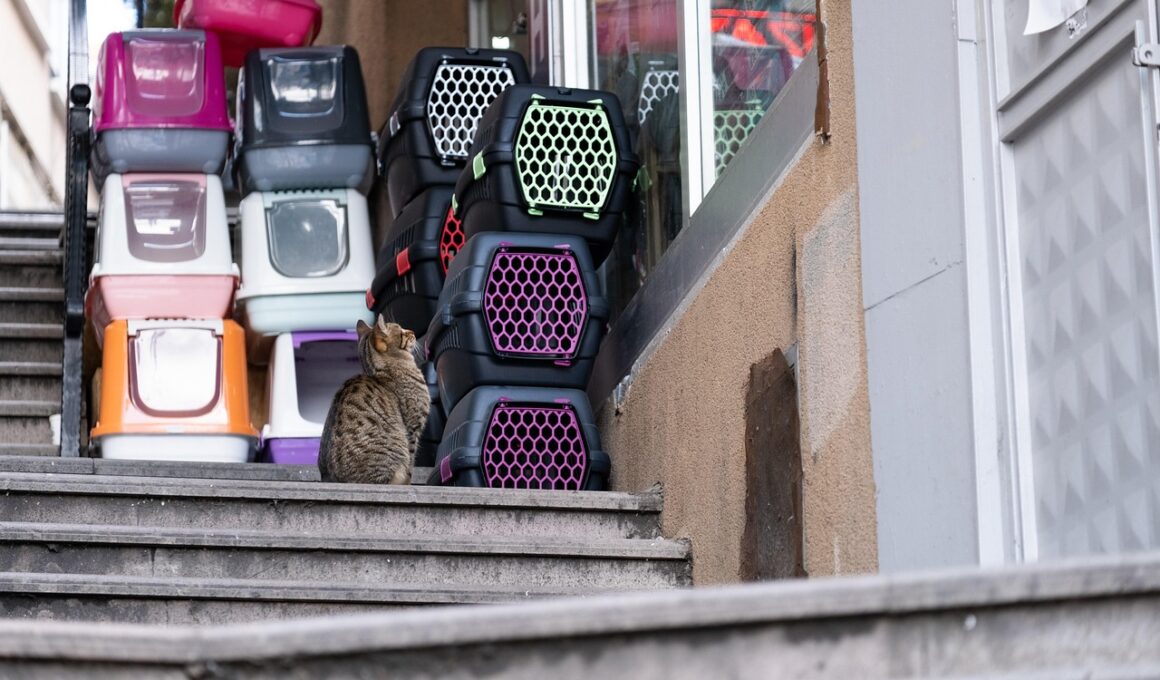Transporting Rescued Cats to Adoption Events Safely
Transporting rescued cats safely to adoption events is essential for their well-being. Stress can significantly affect a cat’s health and behavior during transport. Knowing how to properly prepare them can ensure a smoother journey. First, gather necessary supplies like a sturdy travel carrier, soft bedding, food, and water. Ensure that the carrier is spacious enough for the cat to stand, turn around, and lie down comfortably. Before putting the cat inside, allow them time to explore the carrier so they become familiar with it. This can help reduce anxiety and promote a sense of security. Maintain a calm demeanor when handling the cat, as they can sense your stress. Once ready, secure the carrier in the vehicle to prevent it from moving during transit. Use soft and calming music at a low volume, which can help soothe the cat as you travel. Finally, check the weather conditions and avoid extreme temperatures. If necessary, make frequent stops to provide fresh water and comfort to your furry passenger. By following these steps, you can ensure a tranquil and safe transport experience for your rescued cat.
Monitoring the cat’s health during transport is crucial. Cats may exhibit signs of distress, such as excessive vocalization or hiding. If these signs are noticed, provide comfort by talking softly or reaching in to pet them gently. Consider using a pheromone spray within the carrier, as it can alleviate anxiety by mimicking the comforting scents of their home environment. It’s important to have a vet’s contact information on hand, should any health issues arise during the trip. Additionally, ensure your cat is up to date on vaccinations to avoid any health problems. Some cats may require medication to help them remain calm. Consult with your veterinarian for advice on safe medication options. Plan your route beforehand, considering potential detours or traffic, to minimize travel time. Always have extra supplies, such as food and a litter box, in case of unexpected delays. By being proactive about the cat’s needs, you can create a less stressful experience. Have patience with the rescued animals, as they may not be accustomed to traveling. With careful monitoring and consideration, you can help them adjust to their new journey more comfortably.
Choosing the Right Carrier for Your Cat
Your choice of carrier directly affects the comfort and safety of a transported cat. A well-designed carrier offers security and room for movement, easing anxiety during transit. Look for carriers specifically designed for pets, preferably ones that are airline-approved, ensuring durability and safety for any travel scenario. Consider carriers that allow for ventilation and visibility. Mesh windows or holes promote airflow, while also letting the cat observe the surroundings, helping reduce stress. Ensure the carrier is easy to open and close, especially in emergencies. Familiarize the cat with the carrier by keeping it within their environment for a few days prior to travel. Accessorize the carrier with a familiar blanket or favorite toy, providing comfort and security for your furry friend. Additionally, ensure the carrier has a secure latch to prevent escapes, which could occur during checkout points or stops. Remember to invest time in choosing the right size. A cramped carrier will only increase stress and discomfort, while one that is too large could pose safety risks during transport. By making an informed choice, you can set the stage for a smoother transit experience.
Properly securing the carrier during transit is essential for safety. A moving carrier can frighten the cat or cause injury to them or themselves. Place the carrier on a flat surface, such as the floor of the vehicle, and use seatbelts to secure it. This will minimize movement during sudden stops or turns. Avoid transporting a cat in the back of a truck or in an open vehicle, as this can expose them to danger and distress. If traveling in warm weather, ensure the vehicle has air conditioning, or crack windows for ventilation while remaining cautious against escapes. Should the weather be cold, offer warmth with blankets, and avoid leaving the cat unattended in a vehicle. Frequent breaks can help to comfort stressed cats. Use plenty of positive reinforcement, offering quiet reassurance and treats while they are in transit. One must remember, once you arrive at the event, giving the cat a moment to adjust before removing them from the carrier can help settle them. This gives them a chance to adapt to their surroundings at their own pace and keep them from feeling overwhelmed.
Creating a Calm Environment at Events
Adoption events can be bustling and overwhelming for rescued cats. Each animal requires considerations for such environments to ensure their comfort and well-being. Designate a quiet area within the event for the cats to retreat to if they feel stressed. The space should be away from the main crowd, with limited noise and distraction. Provide cozy bedding and familiar toys to create a comforting environment. Remember, these rescues are likely to come from traumatic backgrounds. To ease initial stress, allow the cats to acclimate themselves before opening the carrier. Give them time to explore their new surroundings. Limit interactions at first to avoid overwhelming them further. Encouraging gentle interactions can help them feel more secure. Train volunteers about appropriate handling techniques. They should wait for the cat to approach before reaching in, as forcing interactions can escalate stress levels. Have calming treats or toys available as well. With the right environment and handling, attendees can feel at ease forming connections with the rescued cats, facilitating successful adoptions and ensuring that these animals are set up for genuine companionship.
Providing education and helpful resources to adopters is essential for the ultimate success of the adoption process. First-time cat owners may have many questions about cat care. Providing them with information on nutrition, health check-ups, and behavioral aspects can greatly enhance their experience. Develop brochures or handouts that detail best practices for indoor cat care. Include information on proper feeding routines, litter box maintenance, and socialization tips. Additionally, stressing the importance of regular veterinary care can help new owners understand their responsibilities. Offer guidance on how to introduce a rescue cat to their new home environment. Discuss patience and gradual introductions to family members and other pets to ensure harmonious coexistence. It may be helpful to showcase common behaviors in rescued cats that could raise concerns, helping new owners identify and address issues early on. Creating an online community or support group for adopters is also a great way to share resources and foster connections with other cat owners. Providing ongoing support can significantly reduce the stress of new responsibilities, enhancing both the owner’s and the cat’s happiness post-adoption.
Conclusion: The Importance of Safe Transports
In conclusion, safely transporting rescued cats for adoption events is paramount to their well-being and successful integration into new homes. The effort of ensuring a calm and secure journey can significantly impact a cat’s stress levels, behavior, and overall health. Proper planning, including carrier choice, vehicle safety, and even the environment of adoption events, plays a critical role in this process. Resources and education for prospective adopters provide invaluable support that helps ensure the longevity of a cat’s placement. Moreover, an informed team of volunteers, trained on handling techniques, fosters an inviting atmosphere that promotes adoption. As rescuers, our collective responsibility is to prioritize the comfort and security of these wonderful animals while creating pathways for successful matches. Taking these measures can help lessen the anxiety these cats might feel in unfamiliar situations. Always remember the importance of patience and understanding as they transition to their new lives. By implementing these best practices, we can create a more compassionate world for our feline companions, ensuring that every rescued cat finds a loving forever home.
Taking the time to create a positive atmosphere for cats and their potential adopters will pay dividends in the long run. Each successful adoption not only changes a cat’s life but also enriches the lives of the adopters. Supported by our knowledge and experience in safely transporting cats and facilitating welfare, there truly is a shared journey that begins at these adoption events. Let’s continue working towards a future where every cat has the chance to experience love, care, and companionship.


